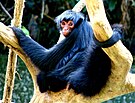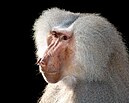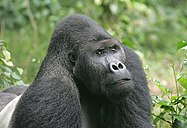| Primates Temporal range:
Early Paleocene to Present
| |
|---|---|
| Scientific classification | |
| Domain: | Eukaryota |
| Kingdom: | Animalia |
| Phylum: | Chordata |
| Class: | Mammalia |
| Mirorder: | Primatomorpha |
| Order: | Primates Linnaeus, 1758[1] |
| Suborders | |
|
sister: Dermoptera | |

| |
| Range and density of non-human primates. | |
| Synonyms | |
|
Plesiadapiformes (cladistically including crown primates[2]) | |
Primates is an order of mammals, which is further divided into the strepsirrhines, which include lemurs, galagos, and lorisids; and the haplorhines, which include tarsiers and simians (monkeys and apes). Primates arose 85–55 million years ago first from small terrestrial mammals, which adapted for life in tropical forests: many primate characteristics represent adaptations to the challenging environment among tree tops, including large brain sizes, binocular vision, color vision, vocalizations, shoulder girdles allowing a large degree of movement in the upper limbs, and opposable thumbs (in most but not all) that enable better grasping and dexterity. Primates range in size from Madame Berthe's mouse lemur, which weighs 30 g (1 oz), to the eastern gorilla, weighing over 200 kg (440 lb). There are 376–524 species of living primates, depending on which classification is used. New primate species continue to be discovered: over 25 species were described in the 2000s, 36 in the 2010s, and six in the 2020s.
Primates have large brains (relative to body size) compared to other mammals, as well as an increased reliance on visual acuity at the expense of the sense of smell, which is the dominant sensory system in most mammals. These features are more developed in monkeys and apes, and noticeably less so in lorises and lemurs. Some primates, including gorillas, humans and baboons, are primarily ground-dwelling rather than arboreal, but all species have adaptations for climbing trees. Arboreal locomotion techniques used include leaping from tree to tree and swinging between branches of trees (brachiation); terrestrial locomotion techniques include walking on two hindlimbs (bipedalism) and modified walking on four limbs (quadripedalism) via knuckle-walking.
Primates are among the most social of all animals, forming pairs or family groups, uni-male harems, and multi-male/multi-female groups. Non-human primates have at least four types of social systems, many defined by the amount of movement by adolescent females between groups. Primates have slower rates of development than other similarly sized mammals, reach maturity later, and have longer lifespans. Primates are also the most cognitively advanced animals, with humans (genus Homo) capable of creating complex languages and sophisticated civilizations, and non-human primates are recorded to use tools. They may communicate using facial and hand gestures, smells and vocalizations.
Close interactions between humans and non-human primates (NHPs) can create opportunities for the transmission of zoonotic diseases, especially virus diseases including herpes, measles, ebola, rabies and hepatitis. Thousands of non-human primates are used in research around the world because of their psychological and physiological similarity to humans. About 60% of primate species are threatened with extinction. Common threats include deforestation, forest fragmentation, monkey drives, and primate hunting for use in medicines, as pets, and for food. Large-scale tropical forest clearing for agriculture most threatens primates.
- ^ Groves, C. P. (2005). Wilson, D. E.; Reeder, D. M. (eds.). Mammal Species of the World: A Taxonomic and Geographic Reference (3rd ed.). Baltimore: Johns Hopkins University Press. pp. 111–184. ISBN 0-801-88221-4. OCLC 62265494.
- ^ Silcox, Mary T.; Bloch, Jonathan I.; Boyer, Doug M.; Chester, Stephen G. B.; López-Torres, Sergi (2017). "The evolutionary radiation of plesiadapiforms". Evolutionary Anthropology: Issues, News, and Reviews. 26 (2): 74–94. doi:10.1002/evan.21526. ISSN 1520-6505. PMID 28429568.







